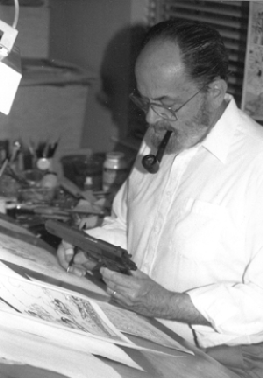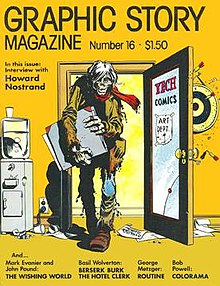
Sergio Aragonés Domenech is a Spanish/Mexican cartoonist and writer best known for his contributions to Mad magazine and creating the comic book Groo the Wanderer.

Mark Stephen Evanier is an American comic book and television writer, known for his work on the animated TV series Garfield and Friends and on the comic book Groo the Wanderer. He is also known for his columns and blog News from ME, and for his work as a historian and biographer of the comics industry, such as his award-winning Jack Kirby biography, Kirby: King of Comics.

A graphic novel is a long-form, fictional work of sequential art. The term graphic novel is often applied broadly, including fiction, non-fiction, and anthologized work, though this practice is highly contested by comics scholars and industry professionals. It is, at least in the United States, typically distinct from the term comic book, which is generally used for comics periodicals and trade paperbacks.
Entertaining Comics, more commonly known as EC Comics, was an American publisher of comic books, which specialized in horror fiction, crime fiction, satire, military fiction, dark fantasy, and science fiction from the 1940s through the mid-1950s, notably the Tales from the Crypt series. Initially, EC was owned by Maxwell Gaines and specialized in educational and child-oriented stories. After Max Gaines' death in a boating accident in 1947, his son William Gaines took over the company and began to print more mature stories, delving into genres of horror, war, fantasy, science-fiction, adventure, and others. Noted for their high quality and shock endings, these stories were also unique in their socially conscious, progressive themes that anticipated the Civil Rights Movement and dawn of 1960s counterculture. In 1954–55, censorship pressures prompted it to concentrate on the humor magazine Mad, leading to the company's greatest and most enduring success. Consequently, by 1956, the company ceased publishing all of its comic lines except Mad.

The Comics Journal, often abbreviated TCJ, is an American magazine of news and criticism pertaining to comic books, comic strips and graphic novels. Known for its lengthy interviews with comic creators, pointed editorials and scathing reviews of the products of the mainstream comics industry, the magazine promotes the view that comics are a fine art, meriting broader cultural respect, and thus should be evaluated with higher critical standards.

Comics Buyer's Guide, established in 1971, was the longest-running English-language periodical reporting on the American comic book industry. It awarded its annual Comics Buyer's Guide Fan Awards from 1983 to circa 2010. The publication ceased with the March 2013 issue. The magazine was headquartered in Iola, Wisconsin, after originally being published in the Quad Cities region.

witzend, published on an irregular schedule spanning decades, is an underground comic showcasing contributions by comic book professionals, leading illustrators and new artists. witzend was launched in 1966 by the writer-artist Wallace Wood, who handed the reins to Bill Pearson from 1968 to 1985. The title was printed in lower-case.

Basil Wolverton was an American cartoonist and illustrator known for his intricately detailed grotesques of bizarre or misshapen people. Wolverton was described as "Producer of Preposterous Pictures of Peculiar People who Prowl this Perplexing Planet." His many publishers included Marvel Comics and Mad magazine.

John Powers Severin was an American comics artist noted for his distinctive work with EC Comics, primarily on the war comics Two-Fisted Tales and Frontline Combat; for Marvel Comics, especially its war and Western comics; and for his 45-year stint with the satiric magazine Cracked. He was one of the founding cartoonists of Mad in 1952.
A script is a document describing the narrative and dialogue of a comic book in detail. It is the comic book equivalent of a television program teleplay or a film screenplay.
Howard Eugene Day was a Canadian comics artist best known for his work on Marvel Comics' Star Wars licensed series and Master of Kung Fu. He was considered a mentor by independent comic writer/artist Dave Sim.
The Alley Award was an American annual series of comic book fan awards, first presented in 1962 for comics published in 1961. Officially organized under the aegis of the Academy of Comic Book Arts and Sciences, the award shared close ties with the fanzine Alter Ego magazine. The Alley is the first known comic book fan award.

Jerome DeFuccio was an American comic book writer and editor known primarily for his work at Mad, where he was an associate editor for 25 years. He was also closely involved in many of the Mad paperbacks, editing Clods' Letters to Mad and many other reprints and spin-offs. Some of his contributions to EC Comics appeared under the pseudonym Jerry Dee.
George Metzger is an American cartoonist and animator. He was an underground comics artist during the mid-1960s and early 1970s in California, eventually relocating to Canada, where he worked in animation.

John Workman is an American editor, writer, artist, designer, colorist and letterer in the comic book industry. He is known for his frequent partnerships with writer/artist Walter Simonson and also for lettering the entire run of Grant Morrison/Rachel Pollack's Doom Patrol.
William Bryan Dubay, who wrote as Bill DuBay and under the pseudonyms Will Richardson, and Dube, was an American comic-book editor, writer and artist best known as editor and writer for Warren Publishing, including that company's horror-comics magazines Creepy, Eerie and Vampirella.

Gary Groth is an American comic book editor, publisher and critic. He is editor-in-chief of The Comics Journal, a co-founder of Fantagraphics Books, and founder of the Harvey Awards.
New Media Distribution/Irjax Enterprises was a comic book distributor and publisher active from the mid-1970s to the mid-1980s. In 1978, the company's legal actions against the dominant distributor of the era, Sea Gate Distributors, widened the field for the direct market to expand. In 1982, when Irjax's distribution arm went out of business, its processing centers and warehouses formed the basis for Diamond Comics Distributors, the now-dominant comics distributor.
Bill Spicer is an editor and publisher who spearheaded the 1960s movement away from commercial comics, opening the gateway to underground, alternative, and independent comics, notably with his publication Graphic Story Magazine.

Alan L. Light is a publisher involved in comics and pop culture fandom. He is best known as the founder of The Buyer's Guide for Comic Fandom, which was the longest-running English-language periodical reporting on the American comic book industry.












